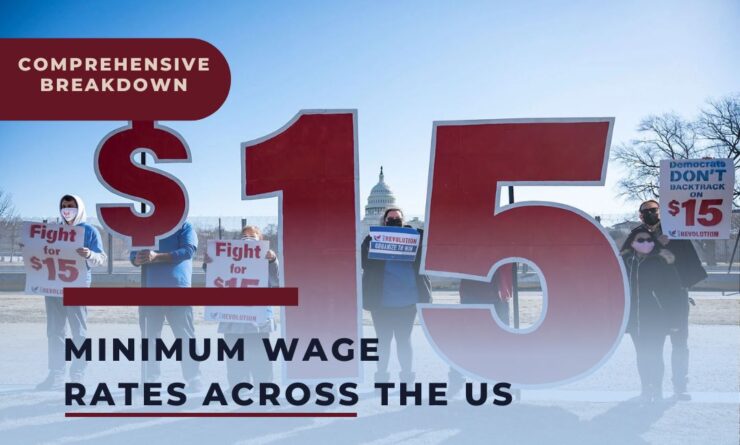As living expenses continue to grow in the U.S., numerous critics assert that the $7.25 per hour federal minimum wage is insufficient.
Although the federal government has not adjusted its minimum wage rate since 2009, several states have been raising their minimum wages over time to better support their residents.
Staying up-to-date with these changes every year can be difficult, particularly for those who employ workers in multiple states.
In this article, we will discuss the minimum wage in all 50 states, as well as who it applies to and how it is determined.
| STATE | MINIMUM WAGE | TIPPED MINIMUM WAGE | DATE IT INCREASES | NOTES |
|---|---|---|---|---|
| Alabama | $7.25 | (no state minimum) | $2.13 | N/A |
| Alaska | $10.85 | $10.85 | Jan. 1, 2024 | Annual cost of living adjustment |
| Arizona | $13.85 | $10.85 | Jan. 1, 2024 | Annual cost of living adjustment |
| Arkansas | $11.00 (for employers of 4 or more employees) | $2.63 | N/A | N/A |
| California | $15.50 | $15.50 | Jan. 1, 2024 | Annual cost of living adjustment |
| Colorado | $13.65 | $10.63 | Jan. 1, 2024 | Annual cost of living adjustment |
| Connecticut | $14.00 | $6.38 (for hotel and restaurant employees) | $8.23 (for bartenders) | June 1, 2024 |
| Delaware | $11.75 | $2.23 | Jan. 1, 2024 | Will increase to $13.25 |
| Florida | $11.00 | $7.98 | Sep. 30, 2024 | Will increase to $12.00 |
| Georgia | $7.25 (for FLSA-covered employees) | $5.15 (non-FLSA employers) | $2.13 | N/A |
| Hawaii | $12.00 | $11.00 | Jan. 1, 2024 | Will increase to $14.00 |
| Idaho | $7.25 | $3.35 | N/A | N/A |
| Illinois | $13.00 | $7.80 | Jan. 1, 2024 | Will increase to $14.00 |
| Indiana | $7.25 | $2.13 | N/A | N/A |
| Iowa | $7.25 | $4.35 | N/A | N/A |
| Kansas | $7.25 | $2.13 | N/A | N/A |
| Kentucky | $7.25 | $2.13 | N/A | N/A |
| Louisiana | $7.25 | $2.13 | N/A | N/A |
| Maine | $13.80 | $6.90 | Jan. 1, 2024 | Annual cost of living adjustment |
| Maryland | $13.25 (for large employers with 15 or more employees) $12.80 (for small employers with fewer than 15 employees) |
$3.63 | Jan. 1, 2024 | Will increase to $14.00 for large employers and $13.40 for small employers |
| Massachusetts | $15.00 | $6.75 | N/A | N/A |
| Michigan | $10.10 | $3.84 | Jan. 1, 2024 | May increase to $10.33 |
| Minnesota | $10.59 (businesses earning over $500k annual gross revenue) $8.63 (businesses earning below $500k annual gross revenue) |
$10.59 (businesses earning over $500k annual gross revenue) $8.63 (businesses earning below $500k gross revenue) |
Jan. 1, 2024 | Annual cost of living adjustment |
| Mississippi | $7.25 (no state minimum) |
$2.13 | N/A | N/A |
| Missouri | $12.00 | $6.00 | Jan. 1, 2024 | Will increase to $14.00 |
| Montana | $9.95 (businesses earning over $110k gross revenue) $4.00 (for businesses not covered by FLSA with below $110k gross revenue) |
$9.95 (businesses earning over $110k gross revenue) $4.00 (for businesses not covered by FLSA with below $110k gross revenue) |
Jan. 1, 2024 | Annual cost of living adjustment |
| Nebraska | $10.50 (for employers of four or more employees) | $2.13 | Jan. 1, 2024 | Will increase to $12.00 |
| Nevada | $9.50 (employees with qualifying health insurance) $10.50 (employees without qualifying health insurance) |
$9.50 (employees with qualifying health insurance) $10.50 (employees without qualifying health insurance) |
July 1, 2024 | Will increase to $10.25 for employees with qualifying health insurance and $11.25 for employees without qualifying health insurance |
| New Hampshire | $7.25 | $3.26 | N/A | N/A |
| New Mexico | $12.00 | $3.00 | N/A | N/A |
| New York | $14.20 $15.00 (Long Island, Westchester, and New York City) |
Varies by region | N/A | N/A |
| North Carolina | $7.25 | $2.13 | N/A | N/A |
| North Dakota | $7.25 | $4.86 | N/A | N/A |
| Ohio | $10.10 (for employers with annual gross receipts of $372,000 or more) $7.25 (for employers with annual gross receipts under $372,000) |
$5.05 | Jan. 1, 2024 | Annual cost of living adjustment |
| Oklahoma | $7.25 (for employers of 10 or more full-time employees at one location or employers with annual gross sales over $100,000) $2.00 (for other non-FLSA employers) |
$2.13 | N/A | N/A |
| Oregon | $12.50 (non-urban counties) $13.50 (standard) $14.75 (Portland Metro) |
$12.50 (non-urban counties) $13.50 (standard) $14.75 (Portland Metro) |
July 1, 2024 | Annual cost of living adjustment |
| Pennsylvania | $7.25 | $2.83 | N/A | N/A |
| South Carolina | $7.25 (no state minimum) |
$2.13 | N/A | N/A |
| South Dakota | $10.80 | $5.40 | Jan. 1, 2024 | Annual cost of living adjustment |
| Tennessee | $7.25 (no state minimum) |
$2.13 | N/A | N/A |
| Texas | $7.25 | $2.13 | N/A | N/A |
| Utah | $7.25 | $2.13 | N/A | N/A |
| Vermont | $13.18 (for employers of two or more employees) | $6.59 | Jan. 1, 2024 | Annual cost of living adjustment |
| Virginia | $12.00 | $2.13 | Jan. 1, 2025 (will increase to $13.50) | |
| Washington | $15.74 | $15.74 | Jan. 1, 2024 | Annual cost of living adjustment |
| West Virginia | $8.75 (for employers of six or more employees in one location) | $2.62 | N/A | N/A |
| Wisconsin | $7.25 | $2.33 | N/A | N/A |
Who is subject to Minimum Wage?
The federal minimum wage applies to non-exempt employees protected under the Fair Labor Standards Act (FLSA). Non-exempt employees typically consist of hourly and blue-collar workers earning less than $684 per week.
The FLSA also exempts certain types of employees from minimum wage regulations, including:
- Employees who regularly receive more than $30 in monthly tips.
- Full-time students working for a retail store, university, or service company, who must be paid at least 85% of the minimum wage.
- Students in a vocational or technical program, who should receive at least 75% of the minimum wage during their enrollment period.
- Employees under 20 years of age completing a three-month probationary period, who should earn at least $4.25 per hour until they complete the probationary period or reach the age of 20 (whichever comes first), at which point they should be paid the minimum wage.
- Employees with mental or physical disabilities that can affect production capacity, such as individuals with drug or alcohol addiction, cerebral palsy, blindness, developmental disabilities, or mental illness.
Minimum Wage: Federal vs. State vs. City States

Cities also have a significant impact on determining the minimum wage rate for standard workers residing there by establishing their own minimum wage rates.
However, if federal, state, and city minimum wages differ, employers must always pay the highest minimum wage.
For instance, California’s minimum wage for standard workers is $15.50 per hour, which is higher than the federal minimum wage. Therefore, employers should pay their workers at least the state’s minimum wage of $15.50 per hour.
If a worker is based in San Francisco, where the minimum wage is $16.99 (higher than California’s rate), employers must pay that worker $16.99 per hour.
Conversely, in states like Wyoming ($5.15) where the minimum wage rate is lower than the federal rate, the higher federal rate of $7.25 per hour applies.
To keep track of all these minimum wage rates and their frequent updates, employers can use payroll software like Hourly, which stays current on minimum wage requirements and allows for easy payment of employees with a single click.
Which States Increased Their Minimum Wages in 2024?
The Economic Policy Institute (EPI) states that 22 states and Washington, D.C., raised their minimum wage on January 1, 2024. Connecticut, Oregon, Nevada, and Florida will follow later in the year.
The states that raised their minimum wages on January 1, 2024, include:
- Alaska
- Arizona
- California
- Colorado
- Delaware
- Illinois
- Maine
- Maryland
- Massachusetts
- Michigan
- Minnesota
- Missouri
- Montana
- Nebraska
- New Jersey
- New Mexico
- Ohio
- Rhode Island
- South Dakota
- Vermont
- Virginia
- Washington
Connecticut’s minimum wage will increase to $15.00 per hour on June 1, 2024, while Florida will raise its rate to $12.00 per hour on September 30, 2024. Oregon has yet to announce the exact figures, but the new rates will be effective from July 1, 2024.
Nevada workers can expect a minimum wage of $11.25 for employees without qualifying health insurance and $10.25 for those with qualifying health insurance, starting from July 1, 2024.
Which States Have a $15 per Hour Minimum Wage?
Washington, California, and Massachusetts are the states with a minimum wage of $15 per hour or more.
Connecticut workers will have a reason to celebrate mid-2024 when the state joins this group as its minimum hourly wage increases to $15 per hour on June 1, 2024. Currently, it is set at $14.00 per hour.
Which States Will See Their Minimum Wage Increase to $15 per Hour in 2024 and Beyond?
In 2024 and later years, thirteen states will experience minimum wage increases to $15 per hour or higher.
The table below outlines these states:
| STATE | SCHEDULED MINIMUM WAGE INCREASE | DATE OF IMPLEMENTATION |
|---|---|---|
| Washington | $15.74 per hour | Jan. 1, 2024 |
| California | $15.50 per hour | Jan. 1, 2024 |
| Massachusetts | $15.00 per hour | Jan. 1, 2024 |
| Connecticut | $15.00 per hour | June 1, 2024 |
| Delaware | $15.00 per hour | Jan. 1, 2025 |
| Florida | $15.00 per hour | Sept. 30, 2026 |
| Hawaii | $16.00 per hour | Jan. 1, 2026 |
| Hawaii | $18.00 per hour | Jan. 1, 2028 |
| Illinois | $15.00 per hour | Jan. 1, 2025 |
| Maryland | $15.00 per hour | Jan. 1, 2025 |
| Nebraska | $15.00 per hour | Jan. 1, 2026 |
| New Jersey | $15.00 per hour | Jan. 1, 2024 (employers with six or more employees) Jan. 1, 2026 (employers with less than six employees) |
| Rhode Island | $15.00 per hour | Jan. 1, 2025 |
| Virginia | $15.00 per hour | Jan. 1, 2026 |
- California
- Connecticut
- Delaware
- Florida
- Illinois
- Maryland
- Massachusetts
- New Jersey
- New York
- Rhode Island
- Vermont
- Virginia
- Washington
Which State Has the Highest Minimum Wage?
Washington boasts the highest minimum wage among all states in the country, currently set at $15.74 per hour. California follows closely with a minimum wage rate of $15.50 per hour.
Here’s an overview of the states with the highest minimum wages:
| State | Minimum Wage Rate (per hour) |
|---|---|
| Washington | $15.74 |
| California | $15.50 |
| Massachusetts | $15.00 |
| New York | $14.20 $15.00 (Long Island, Westchester, and NYC) |
| New Jersey | $14.13 (For large employers) |
| Connecticut | $14.00 |
Which State Has the Lowest Minimum Wage?
Georgia and Wyoming share the lowest minimum wages at $5.15 per hour. However, employers in these states must pay the $7.25 per hour federal minimum wage for employees subject to FLSA regulations.
Five states have no state minimum wage laws and automatically adhere to the federal rate. These states include Alabama, Louisiana, Mississippi, South Carolina, and Tennessee.
Additionally, 13 states have minimum wage laws that match the federal minimum of $7.25 per hour:
- Idaho
- Indiana
- Iowa
- Kansas
- Kentucky
- New Hampshire
- North Carolina
- North Dakota
- Oklahoma
- Pennsylvania
- Texas
- Utah
- Wisconsin
What Is the Minimum Wage for Tipped Employees?
The Department of Labor (DOL) states that the minimum wage for tipped employees is $2.13 per hour in direct wages.
The DOL defines a tipped employee as someone who works in a position where they regularly receive more than $30 in tips per month.
This minimum wage law is applicable only to employees who earn enough tips to meet the minimum wage of $7.25 per hour (or the state/local minimum wage). Employers are responsible for covering the difference if the employee’s wages do not reach the minimum wage.
Different states have distinct wage laws for tipped employees. Consult the table above for more information.
Stay Informed
To help employees cope with the high cost of living and inflation, many states have increased their minimum wages in 2024. Other states have implemented laws that will gradually raise the minimum wage to $15 per hour in the coming years.
Now that you’re familiar with the minimum wages for all states in 2024, the only thing left to do is update your payroll when necessary!














